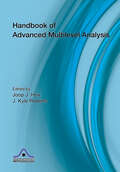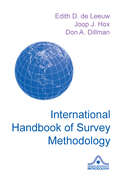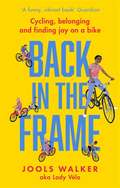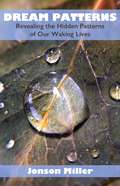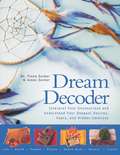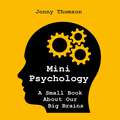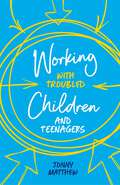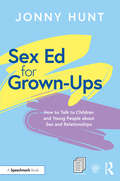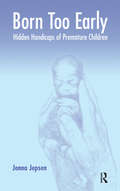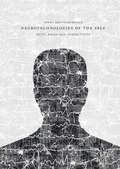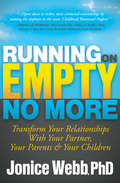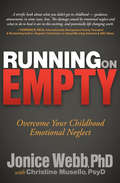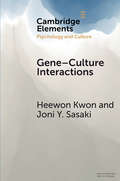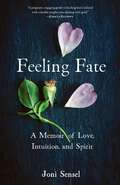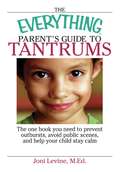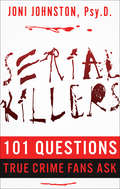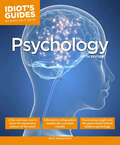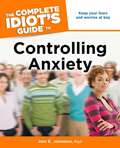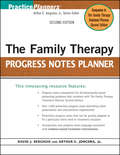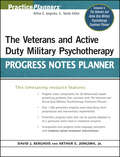- Table View
- List View
Theorie und Praxis des systemischen Ansatzes: Die Systemtheorie Watzlawicks Und Luhmanns Verständlich Erklärt
by Joop Willemse Falko Von AmelnDieses Buch bietet eine verständliche Einführung in das systemische Denken und Arbeiten auf der Grundlage der neueren Systemtheorie. Es führt dabei erstmalig zwei Perspektiven und Theorierichtungen in einem Werk zusammen: Die Systemtheorie Paul Watzlawicks sowie den soziologischen Ansatz von Niklas Luhmann. Ziel ist es, die Grundlagen des systemischen Arbeitens für Studierende, Dozenten und Praktiker eingängig und alltagsnah zu erklären, mit klaren Definitionen und zahlreichen Beispielen aus allen Lebensbereichen. Das Buch ist geeignet für die Vertiefung im Studium und für die Anwendung in Therapie, Beratung und sozialer Arbeit. Dabei werden die Praxisfelder Familie, Wohngruppen und Organisationen besonders beleuchtet. Leserinnen und Lesern dieses Buches werden die Denkweisen der genannten Theorien auf unterhaltsame Weise vermittelt und ein selbstständiger, kreativer Umgang mit ihnen ermöglicht.
Handbook of Advanced Multilevel Analysis (European Association of Methodology Series)
by Joop J. HoxThis new handbook is the definitive resource on advanced topics related to multilevel analysis. The editors assembled the top minds in the field to address the latest applications of multilevel modeling as well as the specific difficulties and methodological problems that are becoming more common as more complicated models are developed. Each chapter features examples that use actual datasets. These datasets, as well as the code to run the models, are available on the book’s website http://www.hlm-online.com . Each chapter includes an introduction that sets the stage for the material to come and a conclusion. Divided into five sections, the first provides a broad introduction to the field that serves as a framework for understanding the latter chapters. Part 2 focuses on multilevel latent variable modeling including item response theory and mixture modeling. Section 3 addresses models used for longitudinal data including growth curve and structural equation modeling. Special estimation problems are examined in section 4 including the difficulties involved in estimating survival analysis, Bayesian estimation, bootstrapping, multiple imputation, and complicated models, including generalized linear models, optimal design in multilevel models, and more. The book’s concluding section focuses on statistical design issues encountered when doing multilevel modeling including nested designs, analyzing cross-classified models, and dyadic data analysis. Intended for methodologists, statisticians, and researchers in a variety of fields including psychology, education, and the social and health sciences, this handbook also serves as an excellent text for graduate and PhD level courses in multilevel modeling. A basic knowledge of multilevel modeling is assumed.
International Handbook of Survey Methodology (European Association of Methodology Series)
by Don A. Dillman Joop J. Hox Edith D. de LeeuwTaking into account both traditional and emerging modes, this comprehensive new Handbook covers all major methodological and statistical issues in designing and analyzing surveys. With contributions from the world's leading survey methodologists and statisticians, this invaluable new resource provides guidance on collecting survey data and creating meaningful results. Featuring examples from a variety of countries, the book reviews such things as how to deal with sample designs, write survey questions, and collect data on the Internet. A thorough review of the procedures associated with multiple modes of collecting sample survey information and applying that combination of methods that fit the situation best is included. The International Handbook of Survey Methodology opens with the foundations of survey design, ranging from sources of error, to ethical issues. This is followed by a section on design that reviews sampling challenges and tips on writing and testing questions for multiple methods. Part three focuses on data collection, from face-to-face interviews, to Internet and interactive voice response, to special challenges involved in mixing these modes within one survey. Analyzing data from both simple and complex surveys is then explored, as well as procedures for adjusting data. The book concludes with a discussion of maintaining quality. Intended for advanced students and researchers in the behavioral, social, and health sciences, this "must have" resource will appeal to those interested in conducting or using survey data from anywhere in the world, especially those interested in comparing results across countries. The book also serves as a state-of-the-art text for graduate level courses and seminars on survey methodology. A companion website contains additional readings and examples.
Back in the Frame: Cycling, belonging and finding joy on a bike
by Jools Walker'We'll all recognise ourselves somewhere in this book' Emily Chappell'One of the best cycling books of all time' BookAuthorityA joyful dose of inspiration that every cyclist, from rookie to randonneur, can take something valuable from' Road.ccIf your bike has become your biggest escape of late, Back in the Frame from award-winning blogger, Lady Vélo, is the book for youJools Walker rediscovered cycling aged 28 after a decade-long absence from the saddle. When she started blogging about her cycle adventures under the alias Lady Vélo, a whole world was opened up to her. But it's hard to find space in an industry not traditionally open to women - especially women of colour.Shortly after getting back on two wheels, Jools was diagnosed with depression and then, in her early thirties, hit by a mini-stroke. Yet, through all of these punctures, one constant remained: Jools' love of cycling.Funny, moving and motivational, this book tells the story of how Jools overcame these challenges, stepped outside her comfort zone and learned to cycle her own path. Along the way she shares a wealth of inspirational stories and tips from other female trailblazers, and shows how cycling can and should be a space for everyone.A celebration of cycling, Back in the Frame will motivate you to get back on your bike and enjoy the ride, no matter what life throws at you.
Back in the Frame: Cycling, belonging and finding joy on a bike
by Jools Walker'We'll all recognise ourselves somewhere in this book' Emily Chappell'One of the best cycling books of all time' BookAuthorityA joyful dose of inspiration that every cyclist, from rookie to randonneur, can take something valuable from' Road.ccIf your bike has become your biggest escape of late, Back in the Frame from award-winning blogger, Lady Vélo, is the book for youJools Walker rediscovered cycling aged 28 after a decade-long absence from the saddle. When she started blogging about her cycle adventures under the alias Lady Vélo, a whole world was opened up to her. But it's hard to find space in an industry not traditionally open to women - especially women of colour.Shortly after getting back on two wheels, Jools was diagnosed with depression and then, in her early thirties, hit by a mini-stroke. Yet, through all of these punctures, one constant remained: Jools' love of cycling.Funny, moving and motivational, this book tells the story of how Jools overcame these challenges, stepped outside her comfort zone and learned to cycle her own path. Along the way she shares a wealth of inspirational stories and tips from other female trailblazers, and shows how cycling can and should be a space for everyone.A celebration of cycling, Back in the Frame will motivate you to get back on your bike and enjoy the ride, no matter what life throws at you.
Dream Patterns: Revealing the Hidden Patterns of our Waking Lives
by Jonson Miller"Dream Patterns" teaches readers to identify the significant, meaningful patterns in their dreams and how to use that knowledge to make changes in their waking lives. Almost every book on dream interpretation emphasizes the interpretation of individual elements of individual dreams. But dreams contain much imagery that is not meaningful or interpretable. "Dream Patterns" shows how to break through the noise created by physical sensations, events of the previous day, intrusions of conscious thinking, and other stimuli to reveal repeating imagery and themes that reflect unrecognized patterns in our waking lives. Awareness of these patterns liberates us from them and empowers us to live our life more skillfully. This book is for dreamers of all skill levels, from people who rarely recall and have never before studied their dreams to people who have spent years studying their dreams but who want to get more out of them. You will learn how to recall, record, and analyze your dreams, and then how to apply the lessons of those dreams to your waking lives. While "Dream Patterns" emphasizes long-term patterns and expresses skepticism about the value of most individual dreams, it does teach you also to recognize and benefit from those few dreams that really are significant in isolation. Such dreams include “big dreams” that reflect major life and spiritual changes.
Dream Decoder: Interpret Your Unconscious and Understand Your Deepest Desires, Fears, and Hidden Emotions
by Jonny Zucker Dr Fiona ZuckerWhat does it mean when you dream about flying? What do the colors in our dreams mean? What does it mean when there are trees or flowers in our dreams? Dr. Fiona Zucker and Jonny Zucker set out in this comprehensive Dream Decoder the answers to all of your questions about your dreams. The chapters unveil the secrets of many aspects of dreaming, including:Life and deathForces of natureDreaming in greenPeople and placesAnimalsEveryday itemsTravelActions and situationsThe human bodyAnd many more!Along with the interpretations of these symbols, the authors also include information on keeping a dream diary, how to prepare for dreaming, how dream catchers work, and how to have and deal with lucid dreams. With Dream Decoder, you will never have to wonder about your dreams again!
Mini Psychology: A Small Book About Our Big Brains
by Jonny Thomson'The most comprehensive - and delightful - guide to the human mind.' STEPHANIE HARRISON'This little book would persuade you that psychology is not just fun but hugely important.' PROFESSOR GEOFF BEATIEWhy do people stay in unhappy relationships?What are the six tricks for successful persuasion?Can personality traits predict future criminality?And what can pigeons tell us about superstitious behaviour?Whether you're a student of psychology or you're just interested in the workings of the brain, Mini Psychology offers a window onto the fascinating mysteries of the human psyche, covering everything from how our memories are formed to why some people are so resistant to change.Focusing on the curious stories behind the abstract theories, it explains the major ideas and names you need to know - and invites you to shine a light on your own inner life.More praise for Jonny Thomson:'Witty, knowledgeable and mind-expanding' RICHARD FISHER 'Engaging, smart and wise' DAVID MITCHELL'A fun and inspiring teaser for curious minds' JÉRÉMIE HARRIS
Mini Psychology: A Small Book About Our Big Brains
by Jonny Thomson'The most comprehensive - and delightful - guide to the human mind.' STEPHANIE HARRISON'This little book would persuade you that psychology is not just fun but hugely important.' PROFESSOR GEOFF BEATIEWhy do people stay in unhappy relationships?What are the six tricks for successful persuasion?Can personality traits predict future criminality?And what can pigeons tell us about superstitious behaviour?Whether you're a student of psychology or you're just interested in the workings of the brain, Mini Psychology offers a window onto the fascinating mysteries of the human psyche, covering everything from how our memories are formed to why some people are so resistant to change.Focusing on the curious stories behind the abstract theories, it explains the major ideas and names you need to know - and invites you to shine a light on your own inner life.More praise for Jonny Thomson:'Witty, knowledgeable and mind-expanding' RICHARD FISHER 'Engaging, smart and wise' DAVID MITCHELL'A fun and inspiring teaser for curious minds' JÉRÉMIE HARRIS
Mini Psychology: A Small Book About Our Big Brains
by Jonny Thomson'The most comprehensive - and delightful - guide to the human mind.' STEPHANIE HARRISON'This little book would persuade you that psychology is not just fun but hugely important.' PROFESSOR GEOFF BEATIEWhy do people stay in unhappy relationships?What are the six tricks for successful persuasion?Can personality traits predict future criminality?And what can pigeons tell us about superstitious behaviour?Whether you're a student of psychology or you're just interested in the workings of the brain, Mini Psychology offers a window onto the fascinating mysteries of the human psyche, covering everything from how our memories are formed to why some people are so resistant to change.Focusing on the curious stories behind the abstract theories, it explains the major ideas and names you need to know - and invites you to shine a light on your own inner life.More praise for Jonny Thomson:'Witty, knowledgeable and mind-expanding' RICHARD FISHER 'Engaging, smart and wise' DAVID MITCHELL'A fun and inspiring teaser for curious minds' JÉRÉMIE HARRIS
Working with Troubled Children and Teenagers
by Jonny MatthewWorking with Troubled Children and Teenagers is an easy to understand guide packed with wisdom for anyone working with or caring for troubled children and teens. Author Jonny Matthew has decades of experience of working with young people, and offers simple but hard-won advice about how to earn the trust and respect of even the most challenging young people. It all starts with you, the adult, adopting a position of respect and patience. It's only then that children and young people will start to respond. From this starting point, Jonny provides a wealth of practical advice across a wide range of challenging topics - from the use of touch and understanding boundaries through to repairing relationships when things break down. Jonny uses case examples and stories throughout to bring his advice to life. This inspiring book is essential reading for any adult invested in improving the lives of troubled children, including youth workers, social workers, foster carers and child counsellors.
Sex Ed for Grown-Ups: How to Talk to Children and Young People about Sex and Relationships
by Jonny HuntWhen it comes to talking to children and young people about sex and relationships, it is difficult to know what to say. How do you answer their questions? How much is too much? And what is age appropriate? Sex Ed for Grown-Ups is an open and honest guide that empowers adults to talk to young people about all things sex and relationships. Written by an independent relationships and sex education consultant, this light-hearted and accessible book encourages grown-ups to think and talk about the topics that scare them the most: from body parts, gender, puberty and first-time sex, to pornography, sexting and knowing what to do when things go wrong. Full of hints, tips and first-hand stories, it is a fun, compassionate and engaging exploration of relationships and sex, which will help adults to fully support young people as they develop a healthy view of both sex and themselves. Sex Ed for Grown-Ups is essential reading for parents, teachers, youth workers, social workers and any adult who wants to have well-informed and positive conversations with the children and young people in their lives.
Born Too Early: Hidden Handicaps of Premature Children
by Jonna JepsenPremature children suffering consequences of their early birth do not grow out of them, and new difficulties may appear as they mature. The sum of negative influences from the time in the Neonatal Intensive Care Unit, eventual problems with interaction, and later a defective or delayed development, can cause continuous problems for premature children. These children can however be protected if we initiate the necessary support. An early effort can prevent the typical consequences of pre-term birth, so that the children will have quite a normal childhood. If the minor difficulties are identified, it is possible to take care of them before they develop into huge problems, and that is just the purpose of this book: to give parents, and professionals close to the child, a possibility to prevent, repair, and rebuild. Born Too Early does not deal with the more usual handicaps but exclusively with the less visible consequences of pre-term birth, which are rarely diagnosed.
Neurotechnologies of the Self
by Jonna BrenninkmeijerTaking care of oneself is increasingly interpreted as taking care of one's brain. Apart from pills, books, food, and games for a better brain, people can also use neurotechnologies for self-improvement. This book explores how the use of brain devices to understand or improve the self changes people's subjectivity. This book describes how the effects of several brain devices were and are demonstrated; how brains and selves interact in the work of early brainwave scientists and contemporary practitioners; how users of neurofeedback (brainwave training) constitute a new mode of self that is extended with a brain and various other (physiological, psychological, material, and sometimes spiritual) entities, ∧ how clients, practitioners and other actors (computers, brain maps, brainwaves) perform a dance of agency during the neurofeedback process. Through these topics, Jonna Brenninkmeijer provides a historical, ethnographical, and theoretical exploration of the mode of being that is constituted when people use a brain device to improve themselves.
Running on Empty No More: Transform Your Relationships with Your Partner, Your Parents & Your Children
by Jonice Webb&“Opens doors to richer, more connected relationships by naming the elephant in the room &‘Childhood Emotional Neglect&’&” (Harville Hendrix, PhD & Helen Lakelly Hunt, PhD, authors of the New York Times bestseller Getting the Love You Want). Since the publication of Running on Empty: Overcome Your Childhood Emotional Neglect, many thousands of people have learned that invisible Childhood Emotional Neglect, or CEN, has been weighing on them their entire lives, and are now in the process of recovery. Running on Empty No More: Transform Your Relationships will offer even more solutions for the effects of CEN on people&’s lives: how to talk about CEN, and heal it, in relationships with partners, parents, and children. &“Filled with examples of well-meaning people struggling in their relationships, Jonice Webb not only illustrates what&’s missing between adults and their parents, husbands, and their wives, and parents and their children; she also explains exactly what to do about it.&” —Terry Real, internationally recognized family therapist, speaker and author, Good Morning America, The Today Show, 20/20, Oprah, and The New York Times &“You will find practical solutions for everyday life to heal yourself and your relationships. This is a terrific new resource that I will be recommending to many clients now and in the future!&” —Dr. Karyl McBride, author of Will I Ever Be Good Enough?
Running on Empty: Overcome Your Childhood Emotional Neglect
by Jonice Webb Christine MuselloThis informative guide helps you identify and heal from childhood emotional neglect so you can be more connected and emotionally present in your life. Do you sometimes feel like you&’re just going through the motions in life? Do you often act like you&’re fine when you secretly feel lonely and disconnected? Perhaps you have a good life and yet somehow it&’s not enough to make you happy. Or perhaps you drink too much, eat too much, or risk too much in an attempt to feel something good. If so, you are not alone—and you may be suffering from emotional neglect. A practicing psychologist for more than twenty years, Jonice Webb has successfully treated numerous patients who come to her believing that something is missing inside them. While many self-help books deal with what happened to you as a child, in Running on Empty, Webb addresses the things that may not have happened for you. What goes unsaid—or what cannot be remembered—can have profound consequences that may be affecting you to this day. Running on Empty will help you understand your experiences and give you clear strategies for healing. It also includes a special chapter for mental health professionals.
Gene–Culture Interactions: Toward an Explanatory Framework (Elements in Psychology and Culture)
by Joni Y. Sasaki Heewon KwonExamining the interconnections between genes and culture is crucial for a more complete understanding of psychological processes. Genetic predispositions may predict different outcomes depending on one's cultural context, and culture may predict different outcomes depending on genetic predispositions - that is, genes and culture interact. Less is understood, however, about how genes and culture interact, or the psychological mechanisms through which gene–culture interactions occur. In this Element, Joni Y. Sasaki and Heewon Kwon review key findings and theories in gene–culture interaction research. They then go on to discuss current issues and future directions in gene–culture research that may illuminate the path toward an explanatory framework.
Feeling Fate: A Memoir of Love, Intuition, and Spirit
by Joni SenselAs her sweetheart&’s body lies cooling on the living room floor, Joni Sensel—shattered but not surprised—revisits her premonition about this moment. From nearly the start of their fairy tale romance less than four years ago, she knew she would lose Tony, the man she considered to be her soul mate. He was in great health, but fate had other plans—a hard truth that visited Joni in the form of a startling vision during their second weekend together. Though she kept the premonition a secret while Tony was alive, upon his death she&’s compelled to share it with his spirit in the form of a letter. A grief memoir with a paranormal twist, Feeling Fate explores how a dark intuition magnified Sensel&’s love and gratitude in the time she and Tony had together before her premonition came true. Faced with evidence of a grand design alongside her grief, she&’s torn between faith and skepticism. While she&’s nearly undone by the pain of her loss, she eventually discovers that a sassy imagination and the irrational insights of the heart can both defeat despair and transform her grief into meaning.
The Everything Parent's Guide To Tantrums: The One Book You Need To Prevent Outbursts, Avoid Public Scenes, And Help Your Child Stay Calm
by Joni LevineDoes your child kick and scream when he doesn't get his way? Have meal times and running errands become emotional battles? The Everything Parent's Guide to Tantrums is your authoritative handbook to understanding what causes your child to have tantrums and which measures you can take to combat their occurrence.Author Joni Levine helps you:Understand your child's temperamentIdentify external influences that trigger tantrumsAvoid responding emotionally to an outburstUse effective methods for calming your childDeal with tantrums in publicFilled with realistic advice and practical tips, The Everything Parent's Guide to Tantrums is your key to a happy, well-adjusted child and peace at home-and elsewhere.
Serial Killers: 101 Questions True Crime Fans Ask
by Joni JohnstonA forensic psychologist answers true crime fan questions and reveals the terrifying truth behind the world’s deadliest serial killers.Serial killers haunt our dreams and inspire the terrifying villains of TV shows and horror movies. But how much do you really know about the minds behind the world’s deadliest killers? What drives these murderers to kill and kill again? And what fuels our fascination with the true stories of their horrific crimes?Now forensic psychologist, private investigator, and crime writer Dr. Joni E. Johnston brings you the answers to these questions and more! Serial Killers: 101 Questions True Crime Fans Ask dives into the case files of the most infamous murderers in history, and answers the questions true crime fans have been dying to ask . . .
When Is It Right To Die?
by Joni Eareckson TadaTada offers a counterbalance to the "quick fix" advice of ending suffering through euthanasia and suicide with hope, compassion and real "death with dignity."
Psychology, Fifth Edition (Idiot's Guides)
by Joni E. JohnstonAuthored by a clinical psychologist, Idiot's Guides: Psychology, Fifth Edition, breaks down all of the complexity of the human mind. Key concepts are explained in plain and simple language, and are supplemented with insightful infographics that help explain each concept in a visual format. Readers will learn everything from the physiology of the brain to the most popular theories of modern psychology to the most famous pioneers in the field (such as Freud and Jung). From behaviorism to social psychology to cognitive psychology, readers will learn what makes all of us tick and why we are who we are.
The Complete Idiot's Guide to Controlling Anxiety
by Joni E. JohnstonGives readers the tools to soothe their nerves. Each year, about one-third of Americans have at least one panic attack, making anxiety disorders among the most common emotional problems. They affect approximately 19 million Americans--more than those suffering from depression, bipolar disorder, schizophrenia, or alcohol abuse. This indispensable guide separates fact from fiction to empower people to regain control over their minds and their lives, shows the differences between normal anxieties and extreme reactions, reveals methods of recognizing anxiety triggers and boosters, and offers calming techniques.
The Family Therapy Progress Notes Planner
by David J. Berghuis Arthur E. JongsmaThe Bestselling treatment planning system for mental health professionals The Family Therapy Progress Notes Planner, Second Edition contains complete prewritten session and patient presentation descriptions for each behavioral problem in The Family Therapy Treatment Planner, Second Edition. The prewritten progress notes can be easily and quickly adapted to fit a particular client need or treatment situation. Saves you hours of time-consuming paperwork, yet offers the freedom to develop customized progress notes Organized around 40 behaviorally based presenting problems, including family-of-origin interference, depression in family members, divorce, financial conflict, adolescent and parent hostility, friction within blended families, traumatic life events, and dependency issues Features over 1,000 prewritten progress notes (summarizing patient presentation, themes of session, and treatment delivered) Provides an array of treatment approaches that correspond with the behavioral problems and DSM-IV-TRTM diagnostic categories in The Family Therapy Treatment Planner, Second Edition Offers sample progress notes that conform to the requirements of most third-party payors and accrediting agencies, including CARF, The Joint Commission (TJC), COA, and the NCQA Presents new and updated information on the role of evidence-based practice in progress notes writing and the special status of progress notes under HIPAA
The Veterans and Active Duty Military Psychotherapy Progress Notes Planner
by David J. Berghuis Arthur E. JongsmaThe Veterans and Active Duty Military Psychotherapy Progress Notes Planner contains complete prewritten session and patient presentation descriptions for each behavioral problem in The Veterans and Active Duty Military Psychotherapy Treatment Planner. The prewritten progress notes can be easily and quickly adapted to fit a particular client need or treatment situation. Saves you hours of time-consuming paperwork, yet offers the freedom to develop customized progress notes Organized around 39 behaviorally based presenting problems, including nightmares, post- deployment reintegration, combat and operational stress reaction, amputation and/or loss of mobility, adjustment to killing, and depression Features over 1,000 prewritten progress notes (summarizing patient presentation, themes of session, and treatment delivered) Provides an array of treatment approaches that correspond with the behavioral problems and DSM-IV-TR diagnostic categories in The Veterans and Active Duty Military Psychotherapy Treatment Planner Offers sample progress notes that conform to the requirements of most third-party payors and accrediting agencies, including CARF, The Joint Commission (TJC), COA, and the NCQA Presents new and updated information on the role of evidence-based practice in progress notes writing and the special status of progress notes under HIPAA

